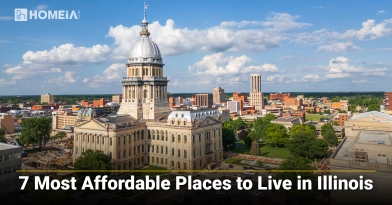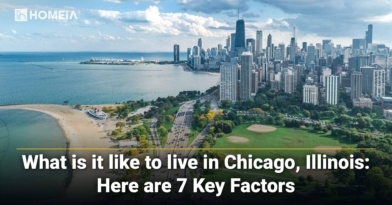The Pros and Cons of Living in Illinois (updated)
- Local Editor:Local Editor: Toby Miller
Published: Jun 13, 2025
- Category: City Living Guide
Relocating to a new state requires careful consideration of both the state as a whole and the specific community you’ll join. If you’re considering Illinois, you’ll find a state home to vibrant cities, charming small towns, and a diverse mix of cultures, beliefs, and landscapes. The Prairie State offers options for all ages, budgets, family situations, and priorities.
This article presents the pros and cons of living in Illinois, including the best cities for various demographic groups. We’ll provide insights to ease your moving process and help you find your perfect Illinois home. From the skyscrapers of Chicago to its rolling farmland, Illinois’ nearly 12.8 million residents enjoy lifestyles shaped by geography, climate, economy, and their local cultures. Whether you’re drawn by its urban amenities, its educational opportunities, or the state’s central location, understanding Illinois’ advantages and challenges is essential before making your move.
Table of Contents:
- I. Methodology: How We Evaluated Illinois
- Pros of Living in Illinois
- Cons of Living in Illinois
- Cost of Living in Illinois
- Best Illinois Cities for Young Professionals
- Best Illinois Communities for Families with Young Kids
- Best Places to Retire in Illinois
- Illinois Lifestyle: Arts, Food, and Recreation
- Frequently Asked Questions About Living in Illinois
Key Takeaways
Economic Diversity: Home to the nation’s third-largest city and a robust agricultural sector, Illinois offers diverse employment opportunities across finance, manufacturing, healthcare, and technology industries.
Lack of Affordable Living, Even Outside Chicago: According to a “press release” from Illinois Policy, “one-third of” Illinois residents “pay over 30% of their income on housing.” It emphasizes that Chicago commands premium prices, with more than 42% of its residents “pay[ing] more than 30% of their income,” and “30% pay[ing] more than half.”
Cultural & Educational Assets: Its world-class museums, universities, and cultural institutions provide residents with exceptional educational opportunities and entertainment options year-round.
Tax Burden & Fiscal Challenges: Illinois has some of the highest property taxes in the nation and has ongoing state budget issues that impact public services and its infrastructure funding.
Climate Extremes: Illinois residents experience all four seasons in full force, with humid summers, bitterly cold winters, and the potential for severe weather including tornadoes.
I. Methodology: How We Evaluated Illinois
Our analysis is based on a multi-factor review of key elements that impact residents’ quality of life and financial well-being. We compiled data from reputable 2025 sources, including the U.S. Census Bureau, Bureau of Labor Statistics, Zillow housing market reports, FBI crime statistics, and state agencies.
Our evaluation criteria are weighted as follows:
- Cost of Living (25%): This foundational metric analyzes the day-to-day expenses that define a household budget, including the cost of groceries, utilities, transportation, and healthcare, all benchmarked against national and regional averages to gauge true purchasing power.
- Economic Health & Opportunity (25%): Long-term stability is non-negotiable. This criterion assesses the robustness of the local economy by examining median household income, unemployment trends, and the diversity of key industries to ensure a community is resilient, growing, and full of potential for its residents.
- Housing & Affordability (20%): This is the most significant financial decision for most. We delve beyond median home prices and rental costs to use crucial ratios like home-price-to-income and income-to-rent, providing a clear picture of how housing costs align with local earnings.
- Quality of Life & Community (20%): Affordability means little without well-being. This metric evaluates the essential factors that contribute to daily life, including access to unique cultural amenities, outdoor recreation opportunities, climate considerations, public safety, and the strength of community engagement.
- Access & Infrastructure (10%): A community’s potential is tied to its connections. This evaluates critical modern infrastructure, including reliable high-speed internet, healthcare access, transportation links, and proximity to major employers and commercial centers.
Our Methodologies to create HOMEiA Score Ratings for Each Group of Content
HOMEiA uses a consistent, data-driven methodology to evaluate U.S. states for livability, affordability, and long-term value. Our analysis centers on key factors such as Housing and Affordability, Cost of Daily Living, Access and Infrastructure, Community Strength, Safety and Quality of Life, Economic Resilience and Job Market Performance…
Pros of Living in Illinois
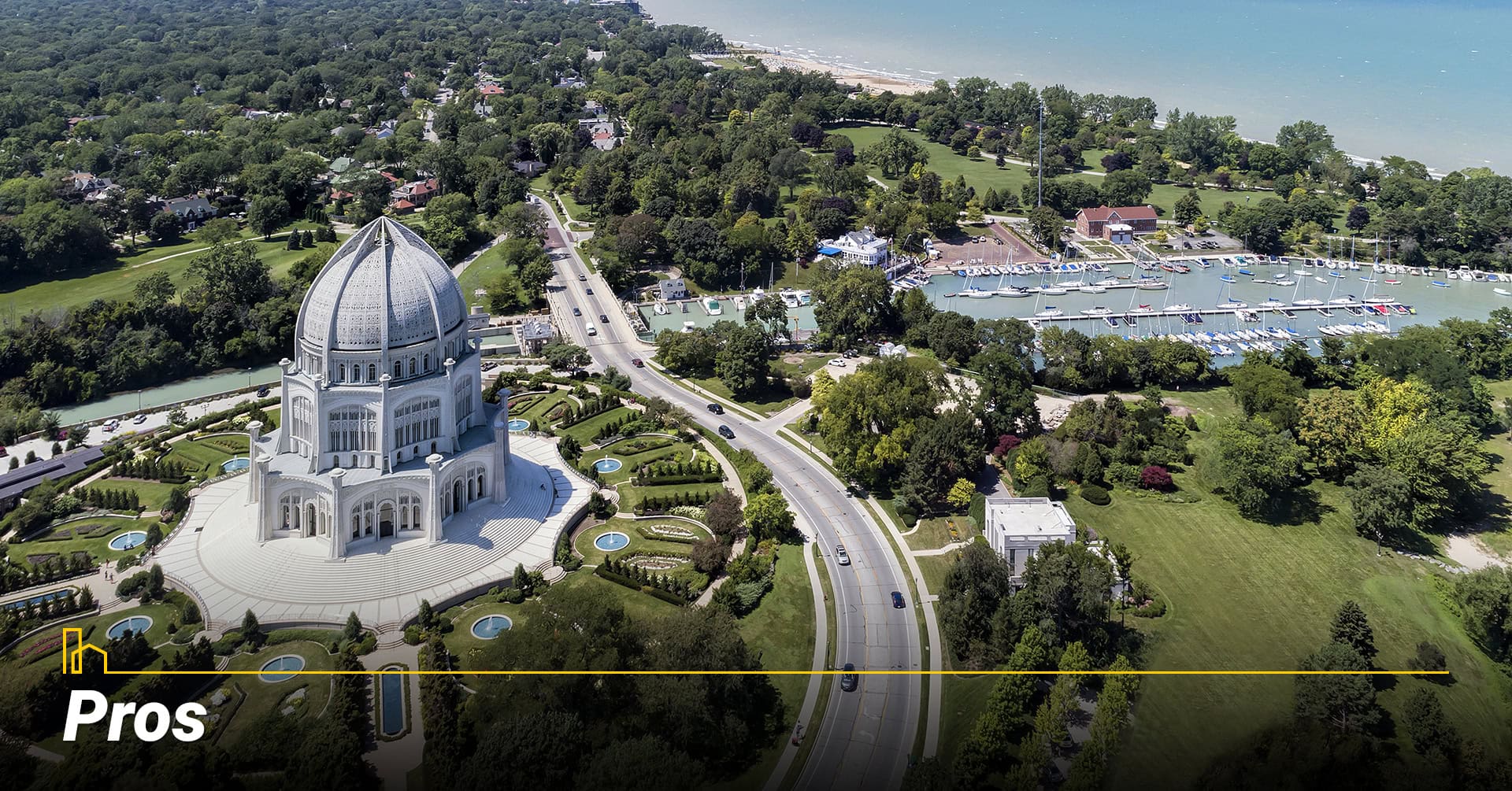
- Different Seasons: For those looking to experience different seasons, Illinois is the place to be. The state is known for both its lengthy Summers and Winters (Funk & Wagnalls New World Encyclopedia). This variety allows for a wide range of outdoor activities-from boating and hiking in the summer to ice skating and skiing in the winter.
- Central Location and Transportation Hub: Illinois is a major transportation crossroads for the nation. Chicago offers two airports through its Department of Aviation, Midway International and O’Hare International Airport (Badertscher). The state’s extensive highway and rail networks make travel easy throughout the Midwest and beyond. This central location is ideal for business, travel, and logistics.
- Economic Diversity and Job Opportunities: Illinois’ economy is valued at more than $1.1 trillion (Pritzker), and is diverse with strengths in agriculture, particularly in growing corn, soybeans, pumpkins, hay, and wheat, as well as in rearing hogs and cattle. Its other strengths include cleaning and purification of food, production of machines and machine equipment, and financial and business support (Badertscher). The city of Chicago is home to more than 30 Fortune 500 companies, including Boeing, McDonald’s, and Walgreens. The state’s “Silicon Prairie” is emerging as a tech hub, while the agricultural sector remains robust in rural areas. As of early 2025, there were 286,000 job openings in Illinois, reflecting the state’s dynamic labor market.
- World-Class Urban Amenities: Chicago is full of things to do and places to visit, including top-tier museums, theaters, shopping, and dining. The city is renowned for its architecture, sports teams, and vibrant nightlife. Other Illinois cities, such as Naperville and Evanston, provide suburban comfort with easy access to big-city amenities.
- Strong Education System: Illinois is home to prestigious universities, including the University of Chicago, Northwestern University, and the University of Illinois at Urbana-Champaign. The Illinois Community College System offers students excellent workforce training and transfer degrees without breaking the bank, and enrollment in Illinois community colleges grew significantly in Spring 2023 (Illinois Community College Board). Many suburban public school districts rank among the nation’s best, with high graduation rates and strong test scores.
- Cultural Diversity: Illinois’s population is a tapestry of cultures throughout the state, reflected in its neighborhoods, festivals, and food scene. Chicago, in particular, is known for its international communities and vibrant arts scene.
- Abundant Recreation and Natural Beauty: Despite common jokes that Illinois is nothing but corn, Illinois offers over 60 state parks, scenic lakes, and rivers for boating, fishing, hiking, and camping. The state’s four seasons provide year-round opportunities for outdoor activities, from summer festivals to winter sports. It must be noted that fishing for sport requires a license and must only be done for recreational purposes, as Illinois values protecting its wildlife (Illinois Register).
- Sports Culture: Illinois is a haven for sportsfans, with major league teams in baseball, football, basketball, and hockey. College sports also have a passionate following, and local high school athletics are a community staple, with local stores selling merchandise to support their high school teams.
- Affordable Cost of Living (Outside Chicago): While Chicago’s cost of living is higher than the national average, much of Illinois is considered affordable. The median home price statewide is around $357,138 as of January 2025, significantly less than the nation’s median of $446,300.
- Rich History: Illinois is steeped in history, from Abraham Lincoln’s legacy in Springfield to the architectural landmarks of Chicago. History buffs will find plenty to explore, including museums, historic sites, and preserved small towns. One can visit preserved historic sites intertwined with his legacy in New Salem in addition to Springfield. Another fascinating historic site to visit is the Cahokia Mounds, an Indigenous site (Badertscher).
Moving to Illinois: The Complete Relocation Guide & Checklist
Illinois’ cost of living is 10% above the U.S. average, driven by housing, though utilities are cheaper. The state offers a diverse climate, strong economy across key industries, rich cultural variety from Chicago to small towns, and excellent transportation networks connecting its urban and rural communities statewide.
Cons of Living in Illinois

- High Taxes: Illinois residents face some of the highest property taxes in the nation, with an average rate of 2.07%- nearly double the U.S. average. Over the course of three years, Chicago residents have had a collective increase of almost $2 billion in property taxes due to tax cuts on businesses (PR Newswire). The state income tax is a flat 4.95%, and combined sales taxes can exceed 10% in some areas, especially in Chicago.
- Harsh Winters and Weather Extremes: The weather in Illinois tends to fluctuate daily because there are no natural structures to direct the wind. Rainfall can vary from around 32 in. in Northwestern Illinois to 48 in Southern Illinois (Funk and Wagnalls). Northern and central Illinois experience frigid temperatures, heavy snowfall, and icy winds from December through March. Tornadoes are a risk in central and southern regions, while river flooding can occur in spring.
- High Cost of Living: The city of Chicago’s cost of living is 15% higher than the national average, with expensive housing, utilities, and transportation. The average rent in Chicago is significantly higher than the state average, and everyday expenses like groceries and healthcare also cost more. However, inflation throughout the state has made workers in other areas require significant income hikes to afford everyday expenses.
- Traffic and Infrastructure Challenges: Chicago is notorious for its traffic congestion, especially during rush hours and winter storms. Roads, bridges, and public transit systems need repair, particularly in older urban and rural areas. Suburban areas tend to have regular construction in the warmer months, which is often a hassle to navigate through.
- Crime and Safety Concerns: Some neighborhoods in Chicago and other cities report higher-than-average rates of violent and property crime. Industrial activity and traffic contribute to air pollution in city areas, especially during summer.
- State Budget and Pension Issues: Illinois faces a significant budget deficit and an underfunded pension system, leading to cuts in public services and concerns about long-term economic health. However, over the course of his position as Governor, J. B. Pritzker has helped the state to get rid of over $12 billion of its debt and pensions funded (Pritzker).
- Population Decline and Economic Disparities: Some rural and small-town areas are experiencing population decline due to limited job opportunities and younger residents moving away. While there are strong sectors, industries like manufacturing and agriculture have seen declines, limiting opportunities in some regions.
- Public School Quality Varies: While some suburbs have top-rated schools, others, especially in rural or low-income areas, suffer from underfunding and lower performance. These disparities in public education are being addressed, with progress noted in increased academic proficiency and graduation rates of marginalized students (Advance Illinois).
- Environmental and Health Concerns: Humid summers bring mosquitoes, ticks, and other pests. Tornadoes, flooding, and, rarely, earthquakes pose risks in certain areas.
- Political Polarization: Chicago leans liberal, while rural areas and several counties are more conservative, leading to political tension and polarization on state and national issues.
7 Most Affordable Places to Live in Illinois
Illinois offers more than its big cities and farmland—it’s also one of the Midwest’s most affordable states. With low median home prices and a diverse economy, it attracts families, retirees, and remote workers alike. This guide reveals seven budget-friendly Illinois communities for 2025, balancing cost, comfort, and Midwestern charm.
Cost of Living in Illinois
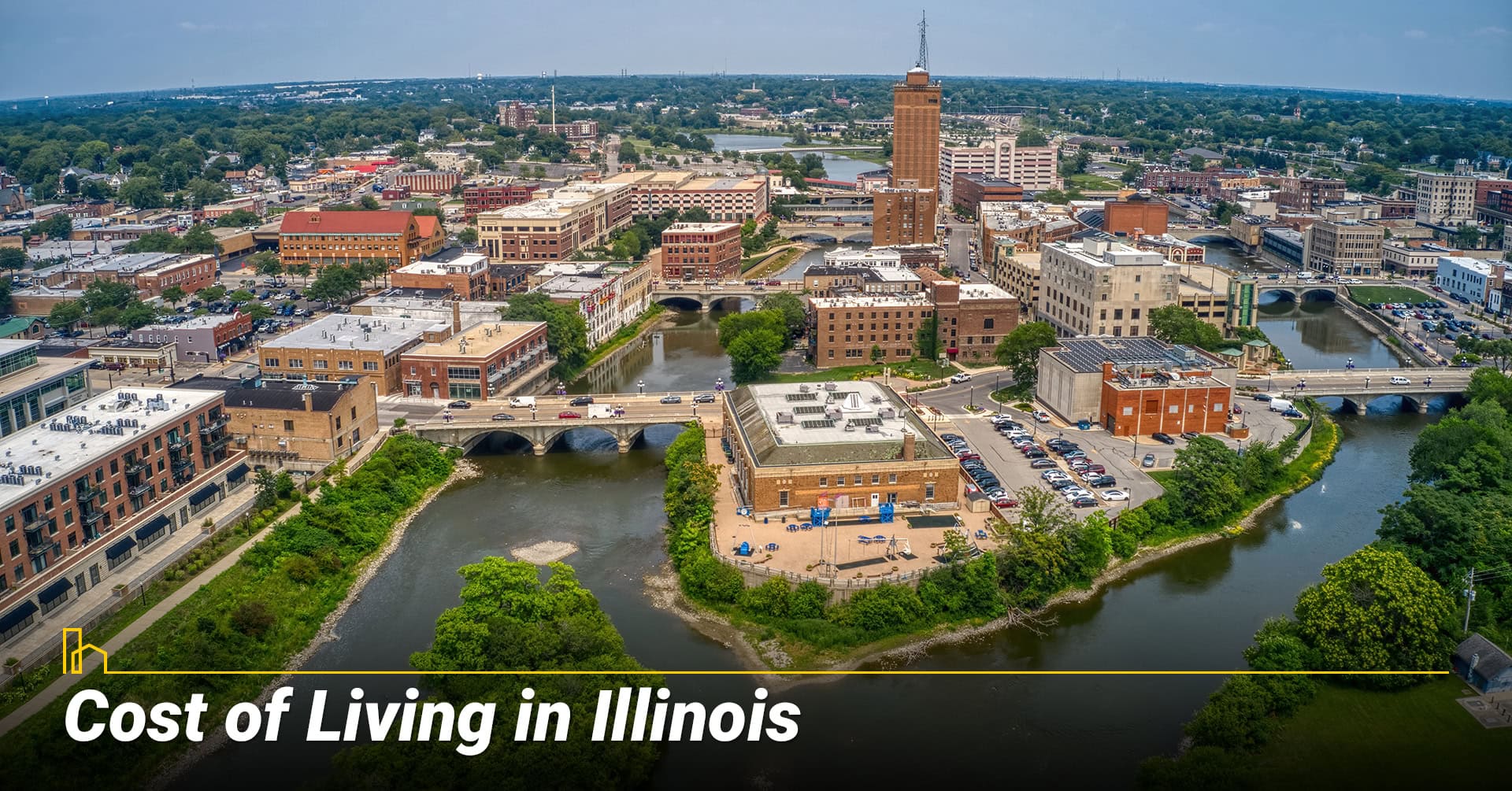
Statewide Overview
- Overall Cost of Living: 8–10% lower than the national average, but this varies widely by region.
- Housing: Median home price is $357,138 (January 2025), up 2.6% from the previous year but still well below the national median.
- Rent: Average rent in Illinois is $1,179, with higher costs in Chicago and affluent suburbs.
- Utilities: 3% lower than the national average.
- Groceries: 2% higher than the national average.
- Healthcare: 4% higher than the national average.
- Transportation: 7% higher than the national average.
- Goods & Services: 5% higher than the national average.
City-by-City Comparison
| City, State | Compared to State Average | Compared to National Average |
| Chicago, IL | 5% higher | 15% higher |
| Bloomington, IL | 6% lower | 3% higher |
| Peoria, IL | 12% lower | 4% lower |
| Quincy, IL | 13% lower | 4% lower |
| Joliet, IL | 14% lower | 6% lower |
| Champaign, IL | 14% lower | 6% lower |
| Carbondale, IL | 16% lower | 8% lower |
| Springfield, IL | 17% lower | 10% lower |
| Rockford, IL | 19% lower | 11% lower |
| Decatur, IL | 28% lower | 21% lower |
Typical Household Expenses
| Expense Category | Average Annual Cost in Illinois | National Average Annual Cost |
| Housing | $28,512 | $35,600 |
| Utilities | $4,896 | $5,628 |
| Food and grocery | $3,923 | $5,021 |
| Healthcare (family) | $24,290 | $25,500 |
| Transportation | $9,346 | $13,174 |
Recommended for you
Best Illinois Cities for Young Professionals
1. Champaign-Urbana
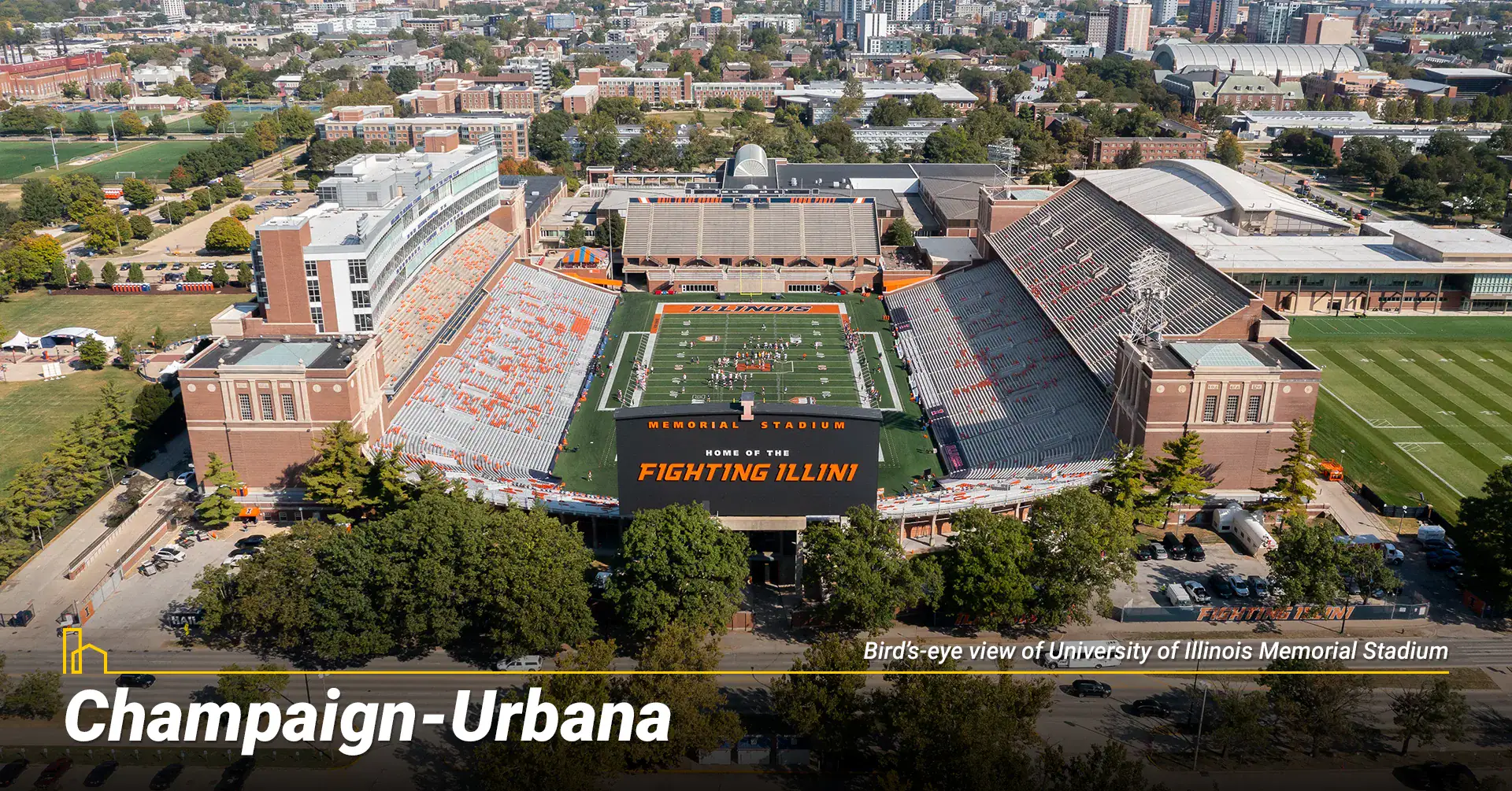
HOMEiA Score: 82/100
- Cost of Living: 5% below U.S. average
- Monthly Rent: $950
- Home price to income ratio: 4.5:1
- Income to rent ratio: 63.2x
- Safety rating: 68/100
Home to the University of Illinois, Champaign-Urbana offers young professionals a dynamic, educated community with affordable living costs. The University of Illinois at Champaign-Urbana drives innovation in technology and research, creating opportunities in emerging fields. The cities’ collaborative atmosphere, growing startup scene, and cultural amenities are fueled by the university community, and make it an attractive option for those seeking career growth without the higher costs of major metropolitan areas.
2. Chicago
HOMEiA Score: 88/100
- Cost of Living: 15% above U.S. average
- Monthly Rent: $2,100
- Home price to income ratio: 8.2:1
- Income to rent ratio: 38.1x
- Safety rating: 52/100
As Illinois’s economic and cultural capital, Chicago offers young professionals unparalleled career opportunities across finance, technology, healthcare, and creative industries. The city’s diverse neighborhoods provide options for a variety of interests with locations to check out like the bustling downtown Loop to trendy areas like Wicker Park and Lincoln Park. With world-class dining, entertainment, and cultural institutions, plus extensive public transportation, Chicago delivers an urban experience that rivals coastal cities at a less expensive price point. The city’s networking scene and numerous opportunities for professional development make it ideal for career advancement.
It should be noted that “housing costs burden 88% of low-income Chicagoans,” according to Elliott Parish at Illinois Policy. Professionals who are just starting out need to consider their abilities to pay for housing in Chicago while building their careers.
3. Naperville
HOMEiA Score: 92/100
- Cost of Living: 20% above U.S. average
- Monthly Rent: $1,900
- Home price to income ratio: 6.8:1
- Income to rent ratio: 52.6x
- Safety rating: 85/100
Located in the Chicago suburbs, Naperville combines small-town charm with big-city amenities and good employment opportunities. Young professionals appreciate the city’s highly-rated school system, safe neighborhoods, and vibrant downtown area with its restaurants, shops, and entertainment venues. With its major employers including Edward Hospital and technology companies, plus its easy access to Chicago via Metra commuter rail, Naperville offers the perfect balance of career opportunity and quality of life outside of work.
The 5 Best Places to Live in Illinois: A City Comparison
Illinois blends world-class cities, small-town charm, and rich farmland, offering diverse lifestyles across the Prairie State. This guide highlights the five best Illinois cities to live in 2025, based on affordability, opportunity, safety, and quality of life—from Chicago’s vibrancy to Urbana-Champaign’s academic appeal in the heart of the Midwest.
Best Illinois Communities for Families with Young Kids
1. Normal
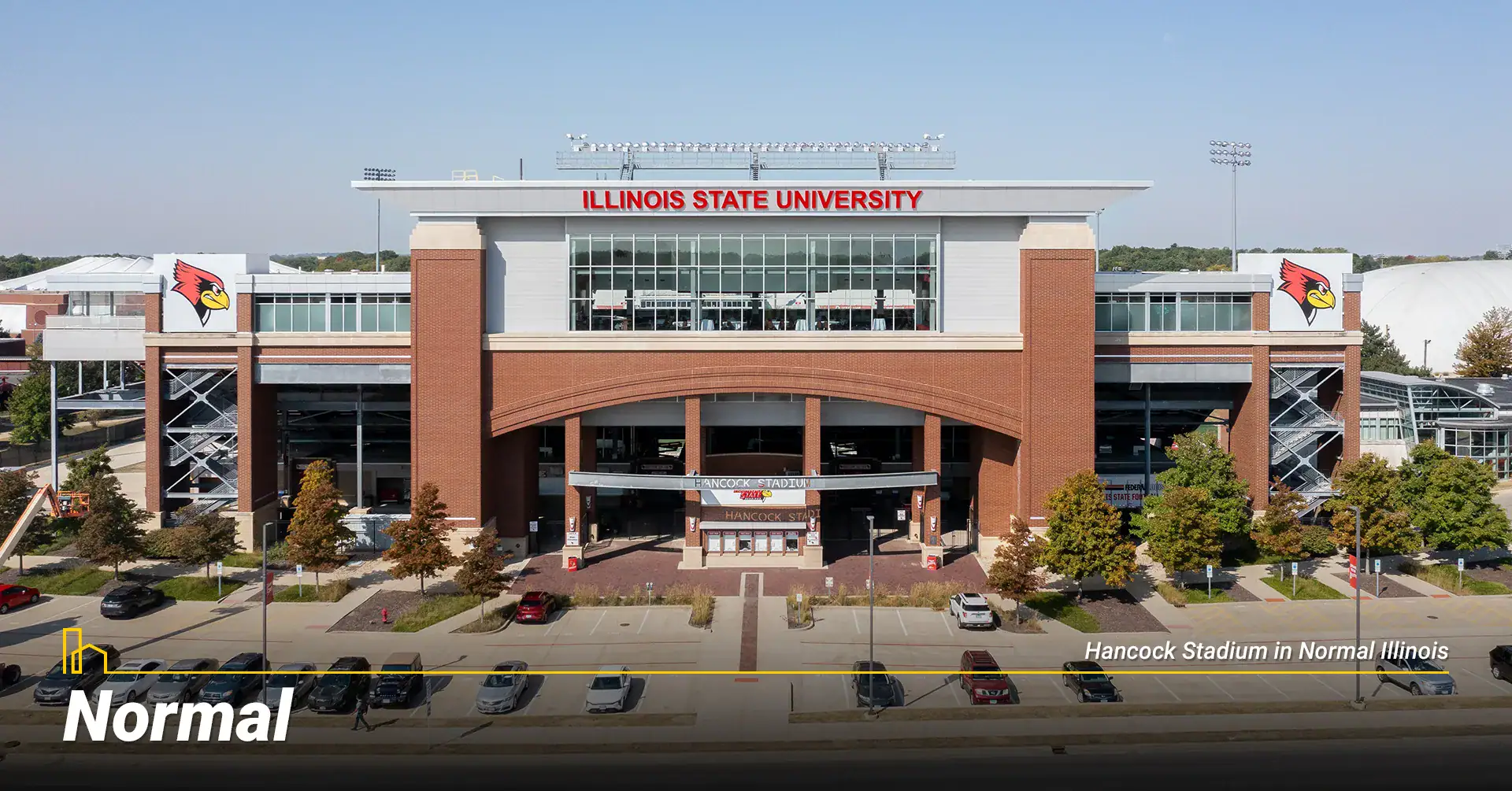
HOMEiA Score: 84/100
- Cost of Living: 6% above U.S. average
- Monthly Rent: $1,000
- Home price to income ratio: 4.2:1
- Income to rent ratio: 60.0x
- Safety rating: 75/100
Part of the Bloomington-Normal metropolitan area, this central Illinois community offers families affordability, quality schools, and a strong sense of community. Home to Illinois State University, the area provides the cultural and educational opportunities typically found in larger cities. The community’s family-friendly amenities, including the Children’s Discovery Museum and extensive park system, make it an excellent choice for those seeking a more affordable alternative to the Chicago suburbs.
2. Geneva
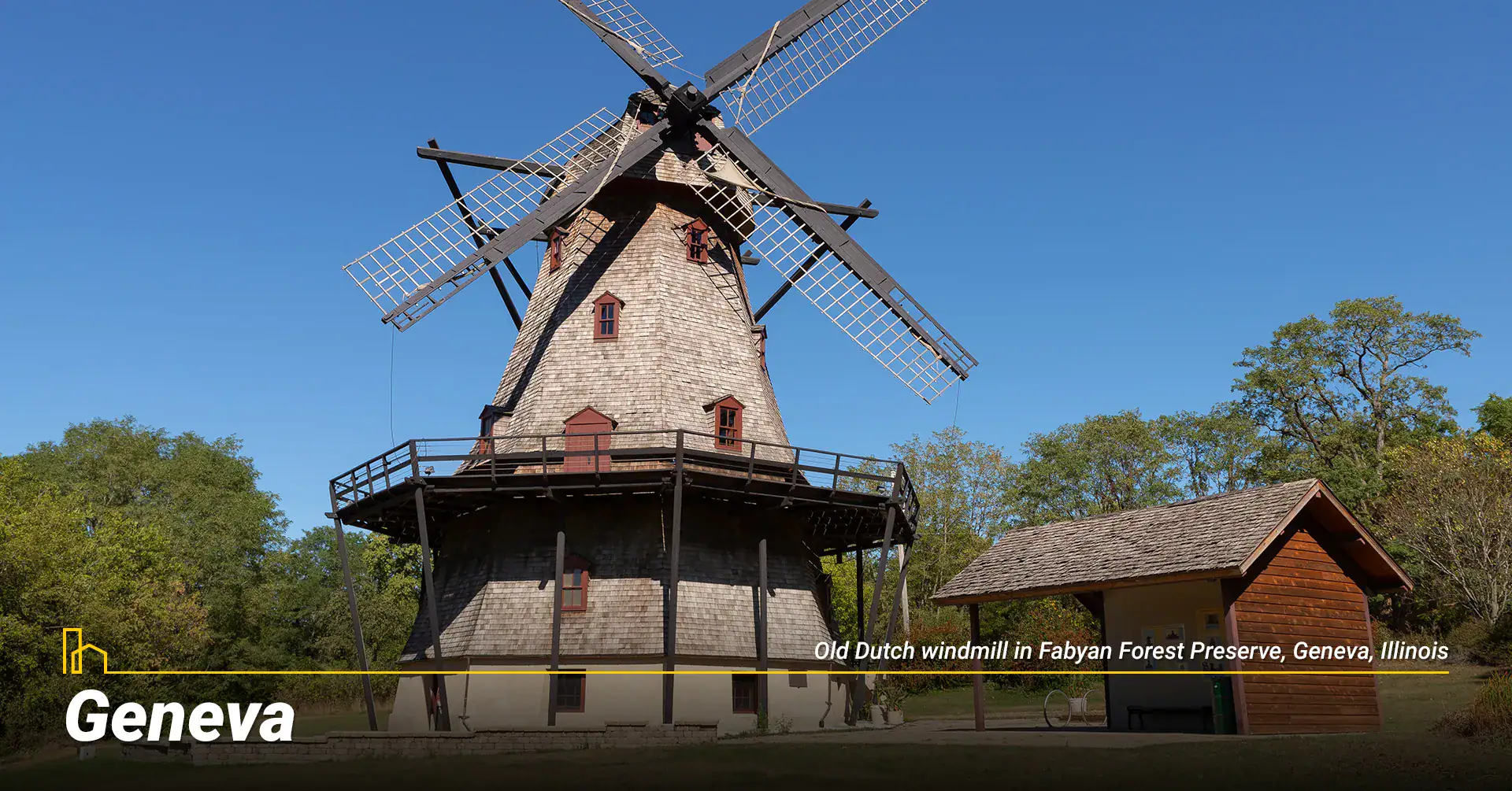
HOMEiA Score: 89/100
- Cost of Living: 22% above U.S. average
- Monthly Rent: $1,800
- Home price to income ratio: 6.2:1
- Income to rent ratio: 55.6x
- Safety rating: 88/100
Located along the Fox River, Geneva combines historic charm with modern amenities in a family-focused community. The city has highly-rated schools, safe neighborhoods, and vibrant downtown area with unique shops and restaurants.. Its extensive park systems, riverfront trails, and community events foster strong connections among residents while providing endless activities for children. This makes it a great place for families to set down roots.
3. Arlington Heights
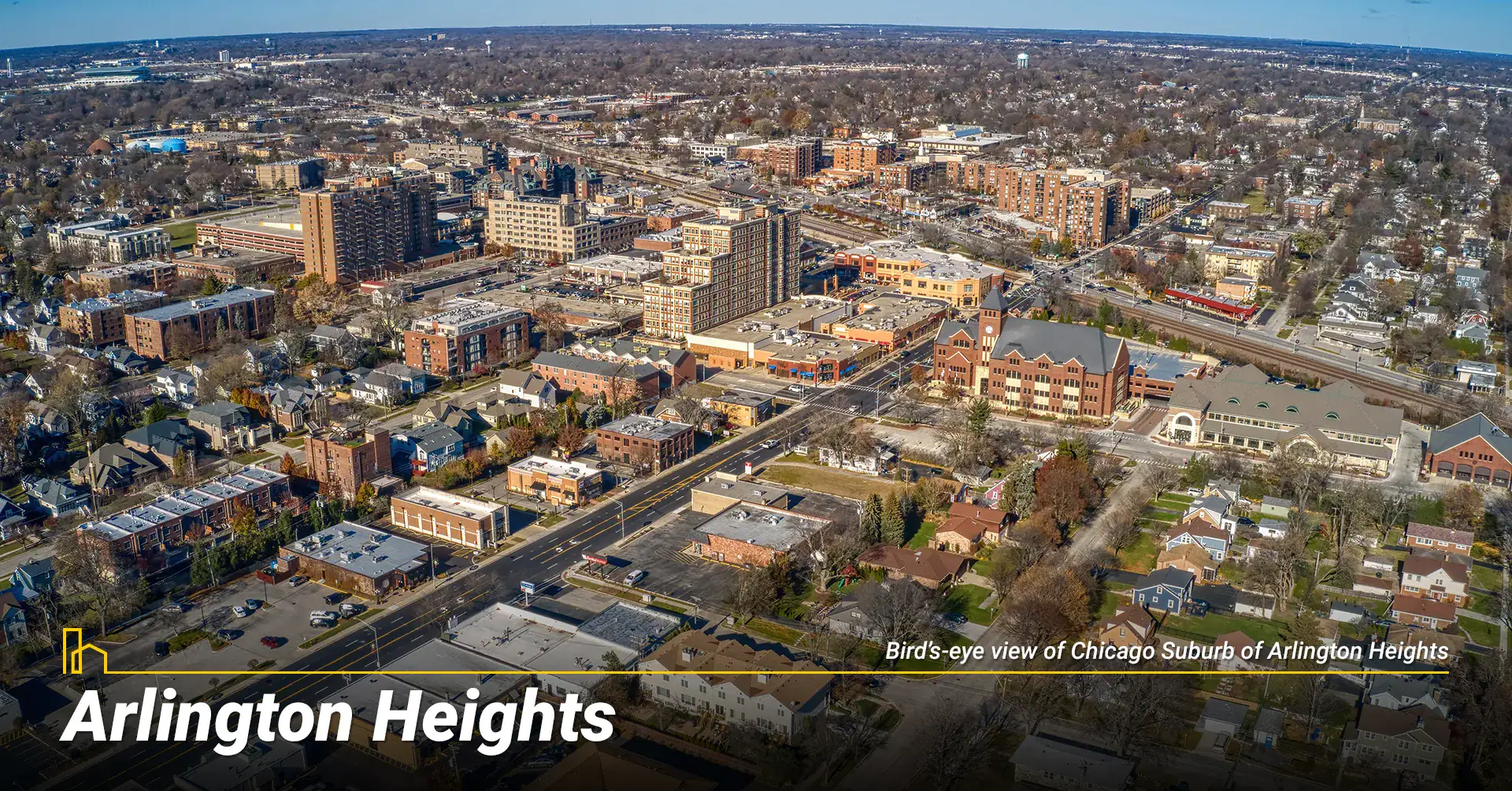
HOMEiA Score: 90/100
- Cost of Living: 18% above U.S. average
- Monthly Rent: $1,700
- Home price to income ratio: 5.9:1
- Income to rent ratio: 58.8x
- Safety rating: 82/100
This northwest suburb consistently ranks among Illinois’s top communities for families, offering excellent public and private schools, safe neighborhoods, and extensive recreational facilities. Families appreciate the community’s numerous parks, family-friendly events, and the convenient access to Chicago via Metra. The village of Arlington Height’s strong sense of community, quality municipal services, and diverse housing options make it an ideal environment for raising children.
7 Key Factors to Know About Living in Chicago, Illinois
Before you consider a move to Chicago, you should consider 7 key factors that will increase your appreciation for the city and guide you to the right neighborhoods and activities for you…
Best Places to Retire in Illinois
1. Quincy

HOMEiA Score: 81/100
- Cost of Living: 4% below U.S. average
- Monthly Rent: $750
- Home price to income ratio: 4.1:1
- Income to rent ratio: 80.0x
- Safety rating: 70/100
Placed along the Mississippi River, Quincy offers retirees exceptional affordability, historic architecture, and a strong sense of community. The city’s well-preserved downtown area, its riverfront amenities, and its numerous parks create an attractive environment for active retirement. With a low cost of living that stretches retirement savings further and quality healthcare facilities, Quincy provides a comfortable place to live for those prioritizing financial security in retirement. For other retirement options, explore the best places to retire in Florida.
2. Springfield
HOMEiA Score: 83/100
- Cost of Living: 10% below U.S. average
- Monthly Rent: $850
- Home price to income ratio: 4.5:1
- Income to rent ratio: 70.6x
- Safety rating: 65/100
As the state capital, Springfield offers retirees affordable living, quality healthcare facilities, and a rich history to explore. The city’s numerous historical sites related to Abraham Lincoln, its cultural attractions, and its parks provide a variety of opportunities for engagement and recreation. It is an ideal area for those interested in historical preservation. One can even visit the preserved home of Abraham Lincoln! Most importantly, with a lower cost of living than many retirement destinations and good access to healthcare through the Southern Illinois University School of Medicine, Springfield represents excellent value for retirees on fixed incomes.
3. Galena
HOMEiA Score: 86/100
- Cost of Living: 5% below U.S. average
- Monthly Rent: $900
- Home price to income ratio: 5.8:1
- Income to rent ratio: 66.7x
- Safety rating: 80/100
Nestled in the northwest corner of Illinois, Galena offers retirees historic charm, natural beauty, and a vibrant arts community. The town’s well-preserved 19th-century architecture, scenic riverfront, and rolling hills create a picturesque setting for retirement. Retirees enjoy the walkable downtown area with unique shops and restaurants, cultural events, and outdoor recreation in the surrounding countryside. The affordable cost of living and strong sense of community make it an attractive option for retirees looking to stay active in their golden years.
What to Know About Parking in Chicago, Illinois
Drivers need to know which options are available, what the rules and regulations say about parking, and where to go when traveling with a car. Knowing these things will mitigate any potential issues that arise. Luckily, Chicago has many options for people who know where to look…
Illinois Lifestyle: Arts, Food, and Recreation

A. Arts and Culture: Illinois has a rich cultural landscape, from Chicago’s world-renowned museums and theaters to vibrant local arts scenes throughout the state. The Art Institute of Chicago, Field Museum, and Museum of Science and Industry rank among the nation’s finest, while smaller cities maintain their own cultural institutions and events specific to the communities they serve. The state’s musical heritage spans blues, jazz, and classical traditions, with festivals and performances year-round that folks from all walks of live come to attend.
B. Food Scene: Illinois’s culinary reputation extends far beyond Chicago’s deep-dish pizza, encompassing diverse ethnic cuisines, innovative farm-to-table restaurants, and classic Midwestern comfort food. The state’s agricultural production and its local farmers’ markets have an interdependent relationship, with smaller restaurants and businesses supporting local food movements. Chicago’s restaurant scene continues to earn international acclaim. From fine dining areas to have seafood and steak to neighborhood eateries serving comfort food after a long day, Illinois offers culinary experiences for every taste and budget.
C. Outdoor Activities: Despite its urban reputation, Illinois provides extensive outdoor recreation opportunities across its diverse landscapes. The state’s park system offers hiking, camping, fishing, and boating, while forest preserves in suburban areas provide places to bike in nature for long miles and get away from the hustle and bustle of everyday life. The Shawnee National Forest in southern Illinois features unique geological formations and wilderness areas to go see and explore.For those looking for aquatic recreation, Lake Michigin is the spot to go swimming and boating. Illinois is a beautiful place in which to exist with nature.
D. Sports and Community Life: Sports culture runs deep in Illinois, from Chicago’s professional teams to passionate college rivalries and local high school athletics. Large chains like Walmart even sell merchandise for fans of the local high school teams. Community life often revolves around local town events, weekly farmers’ markets, and neighborhood events that foster connections among residents. With unpredictable weather, it’s important to wear layers and bring umbrellas to outdoor sporting events.
Conclusion: Is Illinois Right for Your Lifestyle?
Illinois presents a compelling case for those seeking economic opportunity, cultural richness, beautiful natural areas, and diverse communities . The state’s appeal lies in its world-class urban centerand strong educational institutions. Whether you’re building a career in Chicago, raising a family in the suburbs, or enjoying retirement in a historic river town, Illinois offers options for every lifestyle if you can adapt to its tax challenges and climate extremes.
The decision to call Illinois home requires careful consideration of your career goals, family’s needs, and personal preferences regarding urban versus rural living. Weigh the benefits of economic opportunity and cultural amenities against the challenges of taxes and weather to determine if Illinois aligns with your priorities for your next chapter. For those still considering their options, our guide on essential steps for moving to a new city is a great resource.
Recommended for you
Frequently Asked Questions About Living in Illinois
1. What is the cost of living in Illinois compared to other states?
Illinois’s cost of living is near the national average, but Chicago and some suburbs have significantly higher costs. Housing and property taxes are the biggest factors.
2. How severe are winters and storms in Illinois?
Northern and central Illinois experience harsh winters with snow and ice. Tornadoes and flooding are risks in some regions.
3. Is Illinois a good place for families?
Many Illinois cities and suburbs offer excellent schools, parks, and family-friendly amenities. You should research local school ratings and safety to choose the community that fits your needs.
4. What are the job prospects in Illinois?
Illinois’s economy is strong in manufacturing, healthcare, finance, technology, and agriculture. Job opportunities vary by region, with larger cities offering more diverse options.
5. How is healthcare access in Illinois?
Major metropolitan areas offer excellent healthcare facilities, while rural areas may have fewer options. Illinois is home to many top-ranked hospitals and specialists.
6. What are the best outdoor activities in Illinois?
Illinois is known for its state parks, hiking, boating, fishing, golfing, and wildlife viewing. The state’s four seasons offer year-round recreation opportunities.
7. What should newcomers know about Illinois taxes?
Illinois has high property taxes and a flat state income tax. Sales taxes can be high in some areas, especially in Chicago.
Table of Contents:
- I. Methodology: How We Evaluated Illinois
- Pros of Living in Illinois
- Cons of Living in Illinois
- Cost of Living in Illinois
- Best Illinois Cities for Young Professionals
- Best Illinois Communities for Families with Young Kids
- Best Places to Retire in Illinois
- Illinois Lifestyle: Arts, Food, and Recreation
- Frequently Asked Questions About Living in Illinois
Toby Miller lives in Illinois. He is a freelance editor and content writer who has lived in the Prairie State his whole life. He is happily engaged and love marathoning movies with his fiancé and their snuggly cats. He is also a Graphic Design major who loves turning visuals into stories. Between his college studies and work, Toby often checks out more books than he can carry from the library. Toby has experience providing editorial feedback on nonfiction work, like memoirs and articles, and fictional pieces like plays. He enjoys researching to find the best solutions for his projects and treats each editorial project with attention and passion.
HOMEiA is a city guide site where visitors can find detailed information about communities of interest. HOMEiA’s City Guides, created in partnership with local writers and editors, are curated lists of the best, safest, and most affordable places to live. The guides feature the HOMEiA Score, a proprietary index that rates communities on such factors as housing costs, education, employment, etc.
HOMEiA.com aims to be the premier site for people planning to relocate, providing them with insightful content and connecting them with skilled real estate professionals.
We also empower real estate professionals to establish or strengthen their web presence by highlighting their experience, knowledge and achievements. If you’re selected to join our list of certified real estate professionals, you will distinguish yourself from your peers — and earn HOMEiA’s support.
If you believe in HOMEiA’s mission, please share our website with others.
Table of Contents:
- I. Methodology: How We Evaluated Illinois
- Pros of Living in Illinois
- Cons of Living in Illinois
- Cost of Living in Illinois
- Best Illinois Cities for Young Professionals
- Best Illinois Communities for Families with Young Kids
- Best Places to Retire in Illinois
- Illinois Lifestyle: Arts, Food, and Recreation
- Frequently Asked Questions About Living in Illinois



